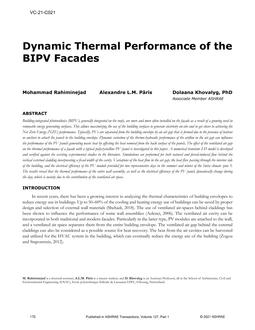Description
Building-integrated photovoltaics (BIPV), generally integrated on the roofs, are more and more often installed on the façade as a result of a growing need inrenewable energy generating surfaces. This allows maximizing the use of the building surfaces to generate electricity on-site and to get closer to achieving theNet Zero Energy (NZE) performance. Typically, PVs are separated from the building envelope by an air gap that is formed due to the presence of battensor anchors to attach the panels to the building envelope. Dynamic variation of the thermo-hydraulic performance of the airflow in the air gap can influencethe performance of the PV panels generating waste heat by affecting the heat removal from the back surface of the panels. The effect of the ventilated air gapon the thermal performance of a façade with a typical polycrystalline PV panel is investigated in this paper. A numerical transient 2-D model is developedand verified against the existing experimental studies in the literature. Simulations are performed for both natural and forced-induced flow behind thevertical external cladding incorporating a fixed width of the cavity. Variations of the heat flow in the air gap, the heat flux passing through the interior sideof the building, and the electrical efficiency of the PV module provided for two representative days in the summer and winter of the Swiss climate zone 5.The results reveal that the thermal performance of the entire wall assembly, as well as the electrical efficiency of the PV panel, dynamically change duringthe day, which is mainly due to the contribution of the ventilated air space.
Citation: 2021 Virtual Conference Papers
Product Details
- Published:
- 2021
- Number of Pages:
- 9
- Units of Measure:
- Dual
- File Size:
- 1 file , 870 KB
- Product Code(s):
- D-VC-21-C021




